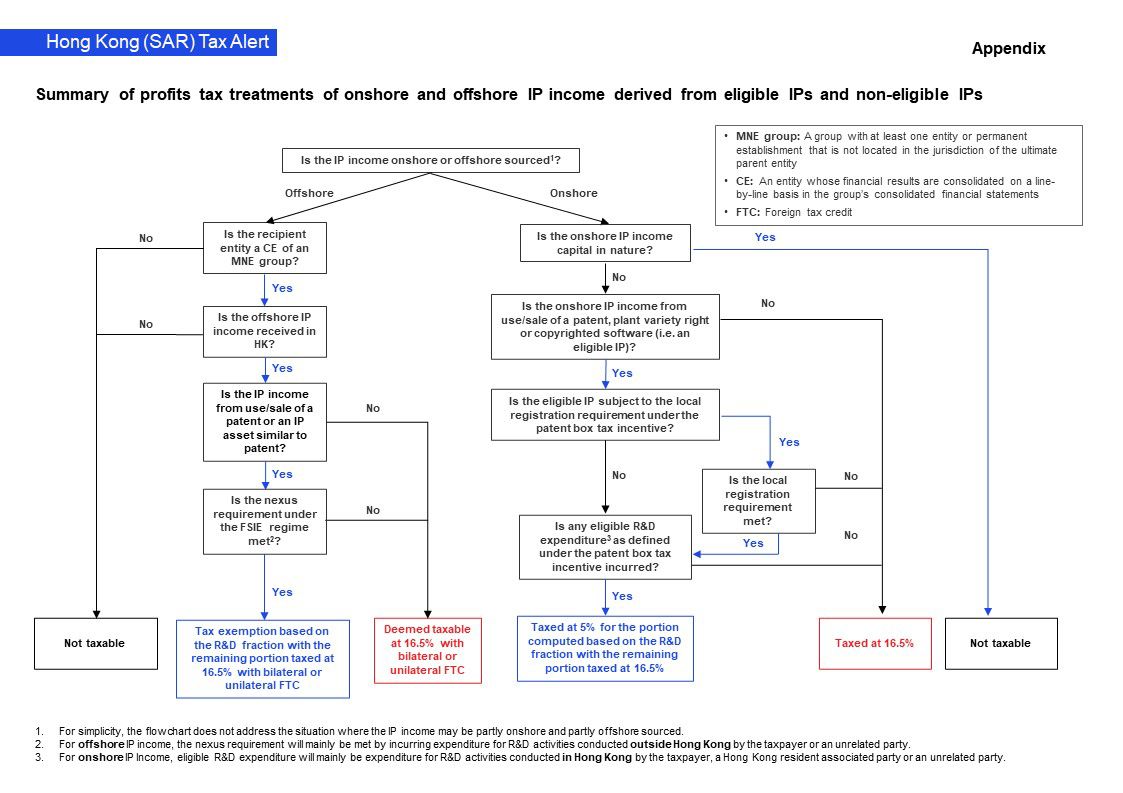Summary
The draft legislation of the patent box tax incentive in the Hong Kong SAR (Hong Kong) was gazetted on 28 March 2024. Upon enactment of the draft legislation, the incentive will be available retrospectively from year of assessment (YOA) 2023/24 to offer a 5% concessionary tax rate for Hong Kong sourced taxable (i.e. non-capital) profits derived from use or sale of eligible intellectual property (IP), subject to certain conditions.
In this tax alert, we summarise the key features of the patent box tax incentive and share our observations.
The Financial Secretary announced in his 2023/24 Budget Speech1 that the HKSAR Government will introduce a patent box tax incentive for Hong Kong-sourced taxable profits derived from qualifying IPs to foster the development of the innovation and technology sector and enhance Hong Kong’s competitiveness as a regional IP trading center. Subsequently, the government launched a consultation in September 2023 (the September consultation) on the proposed incentive.
Following the September consultation, the Inland Revenue (Amendment) (Tax Concessions for Intellectual Property Income) Bill 20242 (the Bill) was gazetted on 28 March 2024 to set out the details of the proposed patent box tax incentive. The Bill will be introduced into the Legislative Council on 10 April 2024. Upon enactment of the Bill, the patent box tax incentive will be available retrospectively from YOA 2023/24.
Key features of the tax incentive
The patent box tax incentive has to adopt the OECD’s nexus approach set out in the BEPS Action 5 Report3 to avoid being regarded as a harmful tax practice. We set out below the key features of the incentive.
1. The tax concession
- Upon an irrevocable election by a taxpayer (which will be made in respect of eligible IP), a 5% concessionary tax rate will apply to a portion of the taxpayer’s Hong Kong sourced taxable (i.e. non-capital in nature) profits derived from use or sale of an eligible IP.
- The concessionary portion of assessable profits will be computed based on the R&D fraction (see details below), which is in line with the OECD’s nexus ratio and the nexus requirement for tax exemption of offshore IP income under the foreign-sourced income exemption (FSIE) regime in Hong Kong.
2. Eligible person
An eligible person for the proposed tax incentive is a person who is entitled to derive eligible IP income from an eligible IP (see discussions below on the scope of eligible IPs and eligible IP income).
KPMG observations:
The above definition means that an eligible person does not need to be the legal owner of an eligible IP. It only needs to be an economic owner who is entitled to the economic benefits generated from an eligible IP. It is also not necessary for the person to be a standalone entity that mainly derives eligible IP income and no other types of income. We are pleased to see that the government has responded to our submission on (1) allowing economic owners of eligible IPs to enjoy the incentive and (2) not imposing the separate entity requirement that is present in some of the existing tax incentives in Hong Kong during the September consultation.
Connect with us
- Find office locations kpmg.findOfficeLocations
- kpmg.emailUs
- Social media @ KPMG kpmg.socialMedia
3. Eligible IPs
- An eligible IP is defined to mean (1) an eligible patent, (2) an eligible plant variety right4 and (3) a copyrighted software under the law of Hong Kong or any place outside Hong Kong.
- An eligible patent essentially refers to a patent granted, or a patent application filed, in Hong Kong5 or by any overseas patent office. For a short-term patent, there is an additional requirement for filing a post-grant substantive examination request with the Patents Registry in Hong Kong within a specified period of time.
- The Bill also contains provisions to deal with divisional patent applications – e.g. if an election to enjoy the concessionary tax rate has been made for an original patent application and there is a related divisional patent application, the election is deemed to have also been made for the divisional patent application.
- For a patent / plant variety right granted outside Hong Kong or an application of such right filed outside Hong Kong, if the date of filing of the right / application is made on or after 24 months after the commencement date of the Bill (i.e. the 24-month grace period), there must be an application for or a grant of a corresponding local patent / local plant variety right in Hong Kong (i.e. the local registration requirement).
- In the circumstances where the 5% concessionary tax rate has been granted but the eligible IP concerned is subsequently revoked, cancelled, declined or withdrawn, etc., the portion of assessable profits previously taxed at the 5% rate will be regarded as the taxpayer’s trading receipts and subject to tax at a rate equal to the difference between the standard profits tax rate and the concessionary tax rate in the year of assessment in which any of the above mentioned circumstances occurs.
KPMG observations:
We welcome the inclusion of a utility model, a utility certificate and an inventor’s certificate issued by an overseas patent office within the scope of eligible patents. As we mentioned in our submission on the September consultation, to make the patent box tax incentive in Hong Kong more competitive, the scope of eligible IPs should be as broad as possible provided that it is allowable under the OECD’s nexus approach. In this regard, we suggest that other IP assets functionally equivalent to patents that are mentioned in the BEPS Action 5 Report6 be regarded as eligible IPs as well and that the list of eligible IPs in the legislation should be updated when necessary.
4. Eligible IP income
Eligible IP income is:
- income derived from an eligible IP in respect of (1) the exhibition or use of, or a right to exhibit or use (whether in or outside Hong Kong) the IP or (2) the imparting of, or undertaking to impart, the knowledge directly or indirectly connected with the use (whether in or outside Hong Kong) of the IP;
- income arising from the sale of an eligible IP;
- the portion of income from a sale of a product or service, determined on a just and reasonable basis (i.e. based on the OECD’s transfer pricing guidelines and profits attribution rules for permanent establishment), that is attributable to the value of an eligible IP; or
- any insurance, damages or compensation amount derived in relation to an eligible IP.
KPMG observations:
We are glad to see that the government has expanded the scope of eligible IP income to include insurance, damages or compensation derived in relation to an eligible IP as compared to the proposal in the September consultation.
5. The R&D fraction and concessionary portion of assessable profits
- The OECD’s nexus approach requires taxpayers to track expenditure incurred and IP income generated and link them to specific IP asset(s). As such, under the patent box tax incentive, the concessionary portion of assessable profits to which the 5% tax rate applies will be computed in respect of an eligible IP (i.e. the subject IP) based on the R&D fraction as follows:

- Types of eligible R&D expenditure and non-eligible expenditure are summarised in the table below:
Types of expenditure incurred |
Eligible R&D expenditure (EE) |
Non-eligible expenditure (NE) |
i. For R&D activities undertaken by the taxpayer in or outside Hong Kong |
Yes |
No |
ii. For R&D activities outsourced to non-associated parties and undertaken in or outside Hong Kong |
Yes |
No |
iii. For R&D activities outsourced to HK resident associated parties and undertaken in Hong Kong |
Yes |
No |
iv. For R&D activities outsourced to HK resident associated parties and undertaken outside Hong Kong |
No |
Yes |
v. For R&D activities outsourced to non-HK resident associated parties and undertaken in or outside Hong Kong |
No |
Yes |
vi. Acquisition costs of eligible IP |
No | Yes |
Note: Interest payments and payments for any land or building (including any alteration, addition or extension) are not regarded as eligible R&D expenditure or non-eligible expenditure.
- The R&D fraction has to be computed based on the cumulative amounts of EE and NE incurred in respect of the subject IP from 1 April 2023 (or an earlier date elected by the taxpayer) onwards. However, as a transitional measure and in cases of insufficient records, the R&D fraction can be computed based on a “3-year rolling average” upon election by a taxpayer for eligible IP income accrued during the period from 1 April 2023 to the last day of the taxpayer’s basis period for the YOA 2025/26. Under this approach, the R&D fraction is computed based on the total EE and NE incurred by the taxpayer in respect of all IP assets during the 3-year period (from the end of the basis period for the YOA during which the eligible IP income accrues) and there is no need to track and link the expenditures to the eligible IP to which the eligible IP income relates.
- If the EE or NE gives rise to multiple IPs, the expenditure has to be apportioned between the subject IP and other IPs on a just and reasonable basis, which is defined in the Bill as the amount representing the extent to which the expenditure was incurred in respect of the subject eligible IP.
KPMG observations:
While the Bill contains provisions to require apportionment of expenditure on a just and reasonable basis in cases the expenditure give rise to multiple IPs, there is no specific provision in the Bill that deals with the situation where multiple IP assets are incorporated into a product or service and overall income is generated from such product or service. Clarification on whether the “product-based” approach mentioned in the OECD’s Action 5 Report can be adopted in such situation will be welcomed.
6. Treatment of losses
Consistent with the requirements set out in the BEPS Action 5 Report7, a tax loss sustained by a taxpayer in relation to income benefiting from the proposed patent box tax incentive can be set off against the taxpayer’s other assessable profits, provided that the loss is adjusted with reference to the tax rate difference (if any).
7. Eligible IP income derived from intra-group licensing arrangements
Unlike some other existing tax incentives in Hong Kong which require a corresponding reduction in the deductible amount of a payment made by a taxpayer (who is subject to profits tax at the normal rate) to a connected person (who is subject to profits tax at a concessionary rate on the payment), the proposed patent box tax incentive does not require such adjustment (under section 16(1A) of the Inland Revenue Ordinance) when royalties are paid by a group company that is subject to the normal 16.5% tax rate to another group company enjoying the 5% tax rate on the royalty income.
KPMG observations:
We are pleased to see that our submission on not imposing the section 16(1A) adjustment is reflected in the Bill. However, taxpayers should bear in mind that there should be justifiable commercial reasons for entering into an intra-group IP licensing arrangement and the related intra-group royalty payments may be subject to the transfer pricing rules in Hong Kong.
8. Notification and record-keeping requirements
There are additional notification and record-keeping requirements under the patent box tax incentive. For example, taxpayers have to notify the Inland Revenue Department in cases a patent previously granted is revoked or cancelled or a patent application previously filed is declined or withdrawn, etc. In addition, relevant transaction and business records have to be retained for 7 years after the completion of those transactions or 7 years after the election to enjoy the incentive was made, whichever is the later.
KPMG observations
We commend the HKSAR Government for introducing a patent box tax incentive in Hong Kong. We look forward to the pragmatic and business-friendly implementation of the incentive for it to serve the policy intent of encouraging more R&D activities and IP commercialisation in Hong Kong.
To further enhance the overall IP tax regime in Hong Kong, we recommend that the following issues be considered: (1) introducing a tax deduction for amortisation expenses for intangible assets in general, (2) enhancing the current tax deduction of IP acquisition costs and (3) considering the impact of Pilar 2 of BEPS 2.0 on the patent box tax incentive and the enhanced tax deduction for R&D expenditure.
Business groups in Hong Kong that carry out IP development and exploitation activities should consider the different Hong Kong profits tax outcomes for onshore and offshore IP income. The flowchart in the Appendix summarises the respective tax treatments of onshore and offshore IP income derived from eligible IPs and non-eligible IPs under the existing FSIE regime and the proposed patent box tax incentive.
1 The 2023/24 Budget Speech can be accessed via this link: https://www.budget.gov.hk/2023/eng/index.html
2 The Bill can be accessed via this link: https://www.gld.gov.hk/egazette/pdf/20242813/es3202428136.pdf
3 The BEPS Action 5 Report can be accessed via this link: https://www.oecd-ilibrary.org/taxation/countering-harmful-tax-practices-more-effectively-taking-into-account-transparency-and-substance-action-5-2015-final-report_9789264241190-en;jsessionid=UGuw0YHwPxS5LRq3kSeIjgIpzU0CtT8OiEck4m2j.ip-10-240-5-190
4 It refers to a right granted or an application filed under the law of Hong Kong or any place outside Hong Kong in respect of a cultivated plant variety.
5 For a brief introduction of types of patents in Hong Kong and their respective filing/application systems, please refer to this link: https://www.ipd.gov.hk/en/patents/patent-basics/index.html
6 The corresponding local patent must be an original grant patent or a short-term patent in Hong Kong and do not include a grant or an application under the standard patent re-registration system in Hong Kong.
7 The nexus approach requires that any tax losses associated with the income benefiting from a preferential IP regime should be used in a manner that is consistent with domestic legislation and that does not allow the set-off of those losses against income that is taxed at the ordinary rate.




